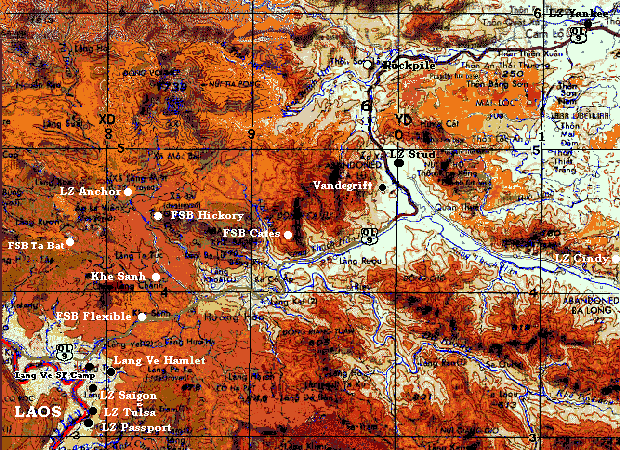



The first part of the operation (Phase 1), which began 0400 hours 29 January 1971, was conducted by U.S. ground forces, in large part made up of the 1st BDE 5th DIV (MECH). Their mission was to open Route 9 to the Laotian border.
On 8 February Phase 2 began and ARVN started their push into Laos. The NVA reacted fiercely, but the ARVN continued its attack supported by U.S. airstrikes and troop lifts by US Army helicopters. South Vietnamese President Nguyen Van Thieu ordered a helicopter assault on the town of Tchepone and this key road junction was captured on 6 March 1971. During this period, US forces were tasked to keep Route 9 open to the border. This involved patrolling by the Infantry units and many small but bloody fights. The rough terrain was the largest enemy. There were few places to escape the NVA rocket and mortar attacks. A/1/61 found an answer that is worth repeating.
With the seizure of Tchepone, Phase 2 of Lam Song 719 was ended.
The last Phase started 16 March and was the withdrawal from Laos by all units. Two weeks of hard combat were necessary for the ARVN task force to fight its way back to Vietnam. During this period D/1/11 and A/1/61 were engaged in heavy combat as they reopened Route 9 after 1/1 Cav Americal refused to fight. By 24 March the last of the Vietnamese Army units were clear and all US Army units returned to their assigned bases.
Losses were heavy in Lam Son 719 both for the Army of Vietnam and the US Army supporting helicopter crews. The ARVN lost almost 50% of their force. U.S. aviation units lost 168 helicopters; another 618 were damaged. Fifty-five U.S. aircrewmen were killed, 178 wounded, and 34 were missing in action as a result of the operation, which lasting until 6 April 1971.
And as so often was the case in Vietnam, the political results of the operation were a disaster. The invasion of a "neutral" country and the loss of human life fueled the protest movement in the US and brought us one step closer to withdrawal from the conflict.
The operations of the 1st BDE 5th DIV are mostly overlooked or a footnote in the descriptions of Lam Son 719. However the dead and wounded dispute any idea that 1/5 was not active during the period. And although the 1/61 as a BN was not a participant in Lam Son 719, its rifle companies were. It was these Infantrymen that provided the real combat power for TF 1/77 Armor. To aid in understanding the ground combat role of the 1st BDE 5th DIV, a map depicting Highway QL 9 as it passes through the Khe Sanh high ground and continues to the Laotian Border is shown below.
 With the terrain in mind click here for a description of the Mission, Maneuver and Losses for the 1st BDE 5th DIV during Lam Song 719.
With the terrain in mind click here for a description of the Mission, Maneuver and Losses for the 1st BDE 5th DIV during Lam Song 719.A first person account of one day of the "Support" operation is at
Pictures from Lam Son 719 and Dewey Canyon II can be found in
Other web sites giving the view from pilots of US helicopters can be found at: